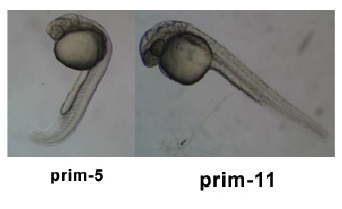Zebrafish Development: Difference between revisions
| Line 1: | Line 1: | ||
[[File:Zebrafish-icon.png|left]] | [[File:Zebrafish-icon.png|left]] | ||
== Introduction == | == Introduction == | ||
Zebrafish or zebra danio (''danio rerio'') are seen as the latest "model' for embryological development studies. These embryos have the great advantage that they develop as "see through" embryos, that is, all internal development can be clearly observed from the outside in the living embryo. | Zebrafish or zebra danio (''danio rerio'') are seen as the latest "model' for embryological development studies. These embryos have the great advantage that they develop as "see through" embryos, that is, all internal development can be clearly observed from the outside in the living embryo. Much of the early work using this embryo model began with Kimmel.<ref><pubmed>7229136</pubmed></ref> | ||
Several large laboratories in the US are now developing large breeding programs to carry out "knockouts" and to find spontaneous mutants of interest. | Several large laboratories in the US are now developing large breeding programs to carry out "knockouts" and to find spontaneous mutants of interest. | ||
Revision as of 15:16, 21 November 2010
Introduction
Zebrafish or zebra danio (danio rerio) are seen as the latest "model' for embryological development studies. These embryos have the great advantage that they develop as "see through" embryos, that is, all internal development can be clearly observed from the outside in the living embryo. Much of the early work using this embryo model began with Kimmel.[1]
Several large laboratories in the US are now developing large breeding programs to carry out "knockouts" and to find spontaneous mutants of interest.
Links: Movie - Zebrafish Heart | 2009 ANAT2341 Group Project - Zebrafish | original Zebrafish page
Some Recent Findings
|
Timeline and Stages of Embryonic Development
| Duration | Period Name | Image |
| 0 - 0.75 hrs | Zygote Period | 
|
| 0.75 - 2.25 hrs | Cleavage Period | 
|
| 2.25 - 5.25 hrs | Blastula Period | 
|
| 5.25 - 10.33 hrs | Gastrula Period | 
|
| 10.33 - 24 hrs | Segmentation Period | 
|
| 24 - 48 hrs | Pharyngula Period | 
|
| 48-72 hrs | Hatching Period | 
|
| 72 hrs - 30 Days | Larval Period | 
|
References
Reviews
Articles
Search Pubmed
Search Pubmed: Zebrafish Development
Additional Images
| Animal Development: axolotl | bat | cat | chicken | cow | dog | dolphin | echidna | fly | frog | goat | grasshopper | guinea pig | hamster | horse | kangaroo | koala | lizard | medaka | mouse | opossum | pig | platypus | rabbit | rat | salamander | sea squirt | sea urchin | sheep | worm | zebrafish | life cycles | development timetable | development models | K12 |
Glossary Links
- Glossary: A | B | C | D | E | F | G | H | I | J | K | L | M | N | O | P | Q | R | S | T | U | V | W | X | Y | Z | Numbers | Symbols | Term Link
Cite this page: Hill, M.A. (2024, May 23) Embryology Zebrafish Development. Retrieved from https://embryology.med.unsw.edu.au/embryology/index.php/Zebrafish_Development
- © Dr Mark Hill 2024, UNSW Embryology ISBN: 978 0 7334 2609 4 - UNSW CRICOS Provider Code No. 00098G
